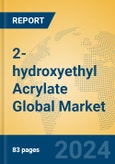The global 2-Hydroxyethyl Acrylate market is projected to reach a value of 0.65-1.15 billion USD by 2025, with an estimated compound annual growth rate (CAGR) of 4.0%-5.5% through 2030. This growth is propelled by rising demand for high-performance materials across multiple sectors, alongside increasing emphasis on sustainability and innovation in chemical applications.
Regional Analysis
The 2-Hydroxyethyl Acrylate market exhibits distinct growth patterns across key regions, driven by industrial capabilities and consumption trends. Asia-Pacific, with China as a dominant player, anticipates growth rates of 4.5%-6.0%. This region benefits from its expansive manufacturing base and growing demand in adhesives and coatings, with trends focusing on scaling production to meet both domestic and export needs. Europe projects a growth range of 3.5%-5.0%, supported by its advanced coatings and textile industries, where market trends emphasize sustainable and eco-friendly solutions.North America expects growth of 4.0%-5.5%, driven by innovation in material applications, particularly in the United States, where trends lean toward integrating 2-Hydroxyethyl Acrylate into high-value, performance-driven products. Latin America and the Middle East & Africa show growth potential of 3.5%-5.0%, tied to emerging industrial sectors, with trends indicating a gradual increase in adoption as manufacturing capabilities expand in countries like Brazil and Saudi Arabia.
Application Analysis
2-Hydroxyethyl Acrylate’s diverse applications underscore its importance across industries, with each segment exhibiting unique growth trajectories and trends:- Adhesives: Estimated growth of 4.5%-6.0%. This segment benefits from 2-Hydroxyethyl Acrylate’s ability to enhance bonding strength and flexibility, with trends shifting toward eco-friendly and high-performance adhesive formulations for construction and packaging.
- Coatings: Growth projected at 4.0%-5.5%. The monomer improves durability and adhesion in industrial and architectural coatings, with trends focusing on developing weather-resistant and low-VOC products.
- Textile Treatment Agents: Growth of 3.5%-5.0%. It boosts fabric performance by improving softness and durability, with trends favoring sustainable textile treatments to meet consumer demand for greener products.
- Paper Treatment Agents: Growth estimated at 3.0%-4.5%. Enhances paper strength and quality, driven by rising packaging needs, with trends emphasizing recyclable and biodegradable paper solutions.
- Others: Growth of 2.5%-4.0%. Encompasses specialty applications like sealants and medical materials, where steady demand persists with a focus on niche, high-value uses.
Key Market Players
The 2-Hydroxyethyl Acrylate market features a mix of global and regional producers ensuring a robust supply chain. Dow is a prominent global leader, supplying the monomer for a wide range of industrial applications. Nippon Shokubai, Toagosei, and Osaka Organic Chemical Industry Ltd. are key Japanese players specializing in high-quality monomers to meet diverse industrial needs. In China, Suzhou Hechuang Chemical Co. Ltd. operates with a capacity of 5,000 tons, catering to the domestic market’s growing demand.Dechem Group Ltd., also with a 5,000-ton capacity, strengthens regional supply. Other notable Chinese producers include Taixing Jinyan Chemical Technology Co. Ltd., Anhui Lianhua New Material Co. Ltd., Heze Chang Sheng Yuan Technology Co. Ltd., Anhui Renxin Environmental Protection Materials Co. Ltd., and Chizhou Fangda Science and Technology, all contributing to a competitive and well-supplied market.
Porter’s Five Forces Analysis
- Threat of New Entrants: Moderate. While the market offers growth opportunities, technical expertise and capital investment in production facilities pose barriers to entry, though rising demand may encourage new players.
- Threat of Substitutes: Moderate. Alternative monomers like hydroxypropyl acrylate exist, but 2-Hydroxyethyl Acrylate’s unique versatility and performance maintain its competitive edge.
- Bargaining Power of Buyers: High. With multiple suppliers globally, buyers, particularly large industrial users, wield significant leverage, especially in price-sensitive, commoditized segments.
- Bargaining Power of Suppliers: Low. Raw materials such as acrylic acid and ethylene oxide are widely available, reducing supplier influence over pricing and availability.
- Competitive Rivalry: High. The presence of numerous players, from global giants to regional manufacturers, fosters intense competition based on price, quality, and production capacity.
Market Opportunities and Challenges
Opportunities:
- Rising Demand in Adhesives and Coatings: Growth in construction, automotive, and packaging sectors drives demand for high-performance materials, positioning 2-Hydroxyethyl Acrylate as a key enabler.
- Expansion in Emerging Markets: Industrialization in regions like Latin America and Africa presents untapped potential as manufacturing bases develop.
- Sustainability Push: Increasing focus on eco-friendly formulations aligns with the monomer’s adaptability, opening avenues for innovation.
Challenges:
- Raw Material Price Volatility: Fluctuations in the cost of acrylic acid and ethylene oxide can disrupt production economics and profitability.
- Stringent Environmental Regulations: Compliance with global sustainability standards adds complexity and cost to manufacturing processes.
- Intense Competition: High rivalry among suppliers pressures margins, requiring continuous improvements in efficiency and product differentiation.
This product will be delivered within 1-3 business days.
Table of Contents
Companies Mentioned
- Dow
- Nippon Shokubai
- Toagosei
- OSAKA ORGANIC CHEMICAL INDUSTRY LTD.
- Suzhou Hechuang Chemical Co. Ltd.
- Dechem Group Ltd
- Taixing Jinyan Chemical Technology Co. Ltd
- Anhui Lianhua New Material Co. LTD
- Heze Chang Sheng Yuan Technology Co. LTD.
- Anhui Renxin Environmental Protection Materials Co. Ltd.
- Chizhou Fangda Science and Technology








